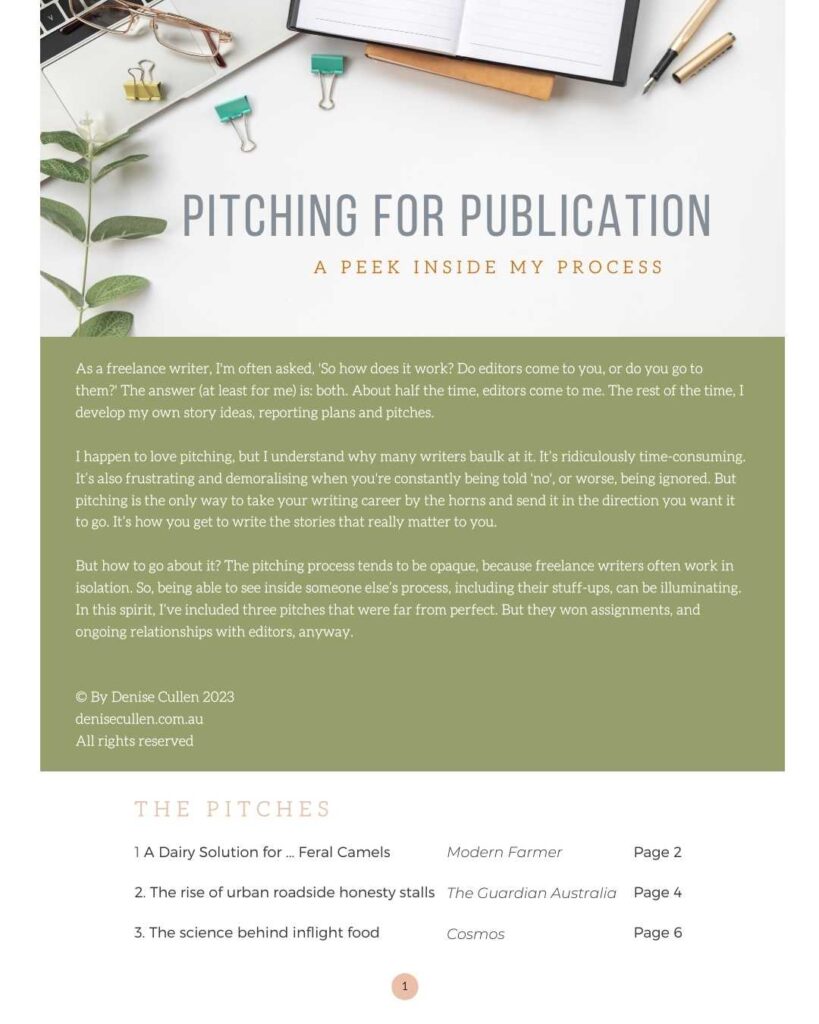‘Write the story that only you can tell.’
I’ve heard editors, writing coaches, and assorted other sources give variations of this advice.
But what on earth does it mean?
Speaking at the Australian Society of Travel Writers (ASTW) Convention in Bendigo in 2025, Craig Platt, digital editor of Traveller, suggested that pitching a story that ‘only you can write’ was one way writers could make their email stand out amid the hundreds of missives editors typically receive each day.
At a previous ASTW convention (in the Tweed, in 2022), he’d ventured into those same waters.
‘It’s got have a hook,’ he said.
‘It can’t just be that something new has happened.
‘Start from a position that readers have no interest in where you went or what you did.’
He recommended including one sentence about why the reader should care, or should do this thing that you felt was worth writing about.
Writing tip 1: Find your voice
I’ve been mulling over what it means to ‘write the story that only you can tell’ ever since.
A lightbulb went on recently when I found myself searching for a story I’d stumbled across about one man’s journey to Chile, a country I happened to be in at the time.
I’d read it in passing while waiting at the Puerto Natales airport, laughed aloud at the writer’s wit, and promptly moved on when the plane started boarding.
But then I couldn’t stop thinking about it, and started googling all the words I could recall to find it again: ‘Chile’, ‘Andes’, ‘mountain’, ‘Viagra’.
Eventually, I found the story, written by British man Sean Thomas, writing for The Times.
As a female, it wasn’t a story I could have written.
(One of the lines is: ‘It looks as if I am going to die, halfway up a volcano, with an erection.’ I hope that’s piqued your interest in reading the whole thing.)
But it probably wasn’t a line any other ‘middle-aged man in less than mint condition’ could have written either.
Thomas’s voice was so clear, his perspective so fresh, his observations so wry.
Even without knowing him personally, it was clear that this was a story that only he could write.
(Learn more about the mindset blocks that get in the way of your writing.)
Writing tip 2: Indulge your curiosity
So, part of it is having a strong, clear, unique voice, but it’s more than just that.
It’s about deploying your one-of-a-kind perspective and using that as a filter to help inform every subsequent writing decision you make.
It involves capturing the details that only you, with your idiosyncratic take on the world, would notice.
It requires stealing whatever spare seconds you can find to record those compelling quotes, gestures, scents, or contradictions before you forget.
‘Writing the story that only you can tell’ means carefully selecting who you choose to talk to – going beyond the often-tedious ‘official talent’ to other interviewees, like the dive instructor, the chef’s apprentice, the gardener, or the room attendant.
It’s about paying attention to your own curiosity.
What made you lean forward, snap a photo, get out of your seat, ask more questions, or take more notes?
No-one can interpret a topic in the same way as you.
‘Write the story that only you can tell’ is about infusing a story with your personality. YOU are the secret spice.
Seeing yourself as one of the key ingredients moves you beyond bland, generic storytelling.
It’s about ensuring your sticky fingerprints are all over the story, that it’s stained with your sweat and sprinkled with the coffee you spilt when you were writing it.
It’s about letting readers forge a visceral connection as they’re reading your work – a connection that ends with your DNA firmly lodged under their fingernails.

Writing tip 3: Incorporate a personal angle
Still roaming around in Chile, I loved this story by Nikki Vargas about ‘What Being Thrown From a Horse in the Atacama Desert Taught Me About Trauma’.
She opens with the ‘frame-by-frame’ account of the accident, before moving onto some of the backstory which would inform her response – her status as an animal lover, her father’s work as a doctor, and her recent viewing of a documentary about the late Christopher Reeve.
It was a story that only Vargas could write.
Wearing another hat, this time as a commissioning editor for Fodor’s Travel, Vargas told Britany Robinson, in her Wild Writing Substack, that she wanted to see freelance writers incorporate more of a personal angle into their pitches.
‘That proposed guide to Valencia becomes a lot more interesting if you’re talking about what it’s like to navigate the city with a disability or as a person of colour,’ she says.
‘When you are able to tie in your personal experience into a travel pitch, it makes it uniquely yours and justifies why you are the one to write the story.’
(Strategies like prewriting can help you corral the disparate collection of threads that emerge during any writing project. To learn more about prewriting, read this.)
Writer Chip Scanlan, says that the stories he’s proudest of are ‘pieces that only I could have written’.
‘Every writer has a territory, a landscape of experience and emotional history unique to them,’ he says.
‘Like any landscape, there are safe havens and dangerous places.’
He urges writers to inhabit and own their individual stories to better spot the universal truths.
Writing tip 4: But be selective about self-disclosure
‘Writing the story that only you can tell’ is sometimes misinterpreted to mean shifting the focus entirely to yourself.
But it’s not about wheeling out lots of self-indulgent ‘I’, ‘me’ and ‘my’.
It’s about using your biography as a starting point, or perhaps a filter, rather than as the star of the show.
It involves selective rather than gratuitous self-disclosure.
You don’t need to spill all the intimate details about your life, just those that make sense in the context of the story.
For instance, Thomas mentions that he lives on London’s Primrose Hill.
His goal isn’t to boast about his affluence, or his celebrity neighbours. (Well, maybe it is, just a little.)
Instead, he’s providing enough background to illustrate why climbing the Andes might be an especially gruelling task for him.
And Vargas doesn’t reveal her status as an animal lover to score empathy from the reader.
It’s to highlight her shock and disconnection she felt when the horse ‘(became) my foe’ in bucking her off his back.
This sense of shock and disconnection instantly transmits to the reader.
Writing tip 5: Dig to uncover a fresh angle
‘Writing the story only you can tell’ can improve your writing no matter what you’re working on.
But, as Platt also mentioned, it’s especially important when you’re going on a tightly scheduled group press trip (famil or fam trip) with five, six, or more other writers who are all following the same itinerary as you.
‘What are you going to write that’s different?’ he asks.
This, as most travel writers can attest, is a very real challenge.
On a press trip, you’re often kept on a very tight leash, with little time or opportunity to go off piste.
But editors demand unique angles and perspectives.
There are many ways to piss them off, but one of the fastest is to lazily or incompetently rehash what’s on the press release or itinerary.
The good news is that even if you walk through the exact same experiences in the exact same order, your colleagues will not have the same internal response.
And there are many other practical strategies you can use to ensure your story stands out.
For instance, drawing on your personal background, especially if it’s unexpected, can help you write a story that is different to that produced by anyone else on that press trip.
Are you a former teacher? Sommelier? Foodie? Science nerd? Professional surfer?
Look at the itinerary through that lens.
If your unique background informs the way you interpret place, that’s your differentiator.
(Keen to learn more about this strategy? I’m currently working on a detailed checklist which will unpack 31 ways to help you write a unique story from a group press trip.
If you’d like a copy, SUBSCRIBE to my newsletter and you’ll be the first to hear about it once it’s released … AND you’ll have the opportunity to purchase it at a deep discount.)

Writing tip 6: Take bigger risks
You can also escape the trap of same-ish writing by taking bigger creative and emotional risks.
That means moving beyond what’s safe, predictable, or formulaic.
Say what no-one else is saying. Experiment with structure. Follow curiosity instead of convention. Pursue unconventional story angles that others overlook.
This can be challenging for writers, who suffer disproportionately from imposter syndrome.
But risk in writing often means exposing your own vulnerability – saying something that feels dangerous to admit.
In her Condé Nast Traveler story, ‘In Taiwan, Tracing a Travel Writer’s Legacy—Alongside My Mother’s Own’, Kat Chen leaps beyond a standard travel feature by combining personal obsession, family history and the legacy of a pioneering travel writer.
The risk came in weaving personal identity and memory with travel reportage.
This yielded a story that only she could write.
(For more tips on taking bigger risks, and other creativity secrets from criminals, read this.)
Writing tip 7: Put on your interpretive glasses
It’s equally important to consider how you reveal what your sources tell you.
Everyone else on the press trip – not to mention anyone with a laptop and an internet connection – can assemble a collection of quotes.
But it’s important to dig a little deeper to uncover what those quotes (or sights, or smells, or sounds) mean.
Think: interpretation, not regurgitation.
Interpretation turns reportage into meaning-making, helping readers understand not only what happened but why it matters.
This great guide to Handling primary and secondary sources as a journalist by Alison Hill emphasises the need to go beyond simply quoting.
Writing tip 8: Just get on with it
Finally, remember that you don’t need anyone else’s permission or credentials to write about a subject that’s important to you, or has moved you in some way.
Writers can sometimes hold back because they think they need formal qualifications, an official title, more education, a collection of clips, or some sort of licence to speak on an issue.
But your authority comes from your lived experience and your capacity to explore a subject deeply and honestly.
If you have a genuine stake in an issue, you have both the right and the responsibility to write about it.
Do so from a place of sincere engagement and thoughtful reflection and you’ll find you have all the authority you need.
While you’re here …
I invite you to subscribe to my newsletter. You’ll receive writing tips every fortnight, breaking news on courses currently under development, and a FREE copy of Pitching for Publication, which deconstructs three successful pitches to Australian and international editors.

